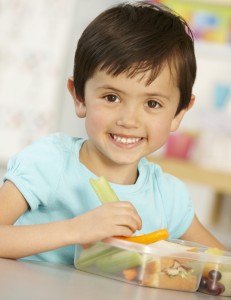 Although breakfast may be the most important meal of the day, lunch is also an essential time for kids to refuel, stay focused and get the energy they need for the rest of the school day.
Although breakfast may be the most important meal of the day, lunch is also an essential time for kids to refuel, stay focused and get the energy they need for the rest of the school day.
“One of the biggest challenges for parents is to pack a healthy lunch that won’t spoil, be traded or end up in the trash,” said Sally Phillips, MS, RD/LD, CDE, a registered dietitian at Akron Children’s.
The key is to have realistic expectations about what your child will eat, while providing balanced nutrition that includes a variety of food groups.
A typical lunch should include a low-fat dairy product, a protein source, such as lean meat, eggs, tuna or peanut butter, and a vegetable, fruit and grain, such as whole grain bread or crackers.
Treats are also important for kids, who will likely crave them or get them somewhere else. Offer healthier options such as an oatmeal cookie, pudding, trail mix or a low-fat granola bar, instead of sugary snacks that offer no nutritional value.
As far as beverages, Phillips’ No. 1 choice is milk because kids need calcium for growing bones. Avoid high-calorie, high-sugar drinks and sodas and save sports drinks for practice and games. Water or a 4 to 6 ounce serving of 100 percent fruit juice are OK, but milk is still the best choice.
Phillips also offers these 12 tips for packing a healthy lunch that kids will eat:
- Buy healthy foods you know your child likes. Separate the fruits, vegetables and healthy treats into three bowls. Each day, let your child select one food from each bowl.
- Involve your child in the lunch-making process, from grocery shopping to helping pack the lunch.
- Make it colorful. Strive to add a variety of colors as well as textures and tastes to each lunch.
- Think beyond a traditional sandwich. Fill a tortilla with low-fat cream cheese and turkey or veggies, roll up and cut into pinwheels. Use a cookie cutter to turn a regular sandwich into fun shapes. Pack cubes of meat and cheese with whole grain crackers.
- Spark your child’s interest with fun food combinations. Make fruit or veggie kabobs with cubes of low-fat cheese. Create “ants on a log” by sprinkling raisins over celery sticks filled with peanut butter.
- Provide dips to make fruits and vegetables more appealing, whether it’s salad dressing for dipping carrot sticks, a yogurt dip for strawberries, or peanut butter for apple slices.
- Pack favorite soups in a thermos, especially on cold winter days. Those that are loaded with vegetables or beans are the best choice.
- Include treats you’ve made together such as homemade trail mix or air-popped popcorn. Remember you may need to include a snack for later.
- Make sure the foods you pack have staying power and will not be soggy or unappealing by lunchtime.
- Keep hot foods hot and cold foods cold. Use a thermos for hot foods. Include a cold pack to keep lunch fresh or freeze a container of yogurt or a juice box, which will be thawed out by lunchtime.
- Consider how much time your child will have for lunch and make sure items can be eaten fairly quickly. For instance, drinkable yogurt is easier to eat than yogurt in a cup.
- Keep it fun by including notes, stickers or silly straws.










